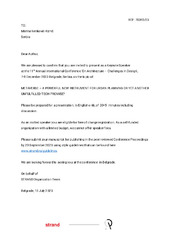Приказ основних података о документу
METAVERSE – A Powerful New Instrument for Urban Planning or Yet Another Unfulfilled Tech-Promise?
| dc.creator | Nenković-Riznić, Marina | |
| dc.date.accessioned | 2023-12-22T10:37:58Z | |
| dc.date.available | 2023-12-22T10:37:58Z | |
| dc.date.issued | 2023 | |
| dc.identifier.isbn | 978-86-89111-34-7 | |
| dc.identifier.uri | http://raumplan.iaus.ac.rs/handle/123456789/925 | |
| dc.description.abstract | Pandemic and post-pandemic conditions left significant impacts not only on human life, but also in all of the aspects of human behavior, which consequently led to serious change in human communication. Often overlapping and interference of “real life“, and virtual, contactless communication influenced accelerated adaptation of people to rapid and immediate change of perspectives. This affected regular interaction among people, but also had consequences in different performance of duties such as scientific development in different fields, or any other development-oriented activities. From that new adaptation, METAVERSE was born, as immersive 3D environment in which people synchronously interact with others, and with representations of objects from the physical world. METAVERSE enables interactions with digital environments and physical objects located in different places and enables individuals to interact with other people in remote locations. Within the realm of urban planning, the emergence of the METAVERSE has sparked both excitement and skepticism. Proponents argue that it possesses the transformative power to revolutionize the way cities are designed, managed, and experienced, while skeptics remain cautious, questioning its viability and potential to deliver tangible benefits. This paper aims to critically examine the METAVERSE as a potent instrument for urban planning or yet another instance of unfulfilled technological promises. By analyzing the concept of the METAVERSE and its fundamental principles, this study seeks to uncover its potential applications in urban planning, especially in the field of participation. It explores the integration of virtual and augmented realities, immersive technologies, and advanced data analytics to create interactive and participatory urban design experiences. Ethical concerns regarding privacy, accessibility, and digital equity are addressed, acknowledging the potential for exacerbating existing social disparities. Additionally, technical constraints, economic feasibility, and the need for robust infrastructure are examined to assess the practicality of widespread METAVERSE adoption in urban planning practices. Through a comprehensive analysis, this paper aims to contribute to a deeper understanding of whether the METAVERSE represents a truly powerful and transformative tool or merely another fleeting technological mirage in the landscape of urban development. | sr |
| dc.language.iso | en | sr |
| dc.publisher | Belgrade : Sustainable Urban Society Association (STRAND) | sr |
| dc.relation | info:eu-repo/grantAgreement/MESTD/inst-2020/200006/RS// | sr |
| dc.rights | openAccess | sr |
| dc.source | Proceedings from STRAND Conference On Architecture - Challenges in Design 2023 | sr |
| dc.subject | METAVERSE | sr |
| dc.subject | urban planning | sr |
| dc.subject | public participation | sr |
| dc.subject | 3D environment | sr |
| dc.title | METAVERSE – A Powerful New Instrument for Urban Planning or Yet Another Unfulfilled Tech-Promise? | sr |
| dc.type | conferenceObject | sr |
| dc.rights.license | ARR | sr |
| dc.citation.spage | 92 | |
| dc.citation.epage | 99 | |
| dc.citation.rank | M31 | |
| dc.identifier.fulltext | http://raumplan.iaus.ac.rs/bitstream/id/3775/2023_STRAND.pdf | |
| dc.identifier.rcub | https://hdl.handle.net/21.15107/rcub_raumplan_925 | |
| dc.type.version | publishedVersion | sr |

